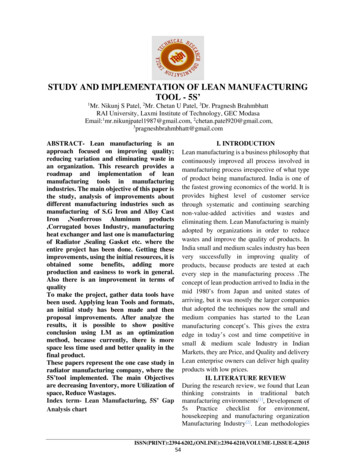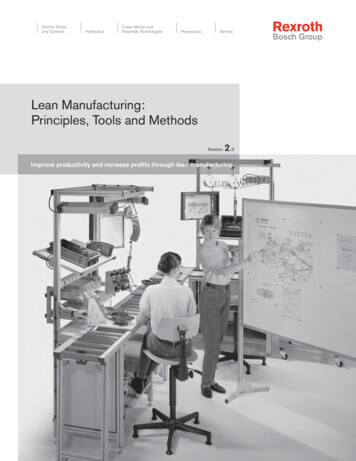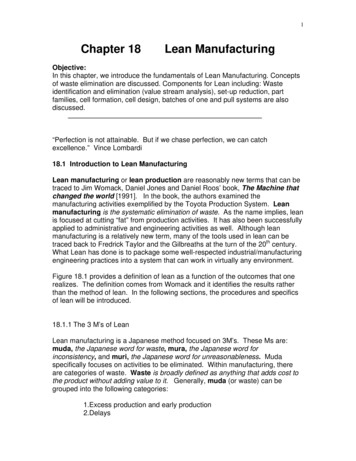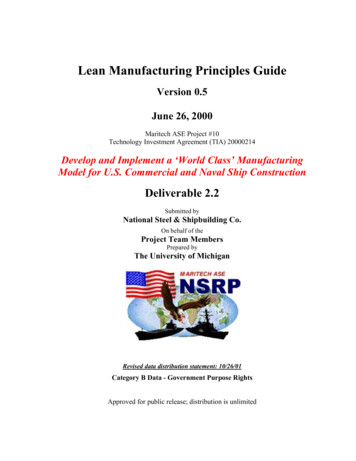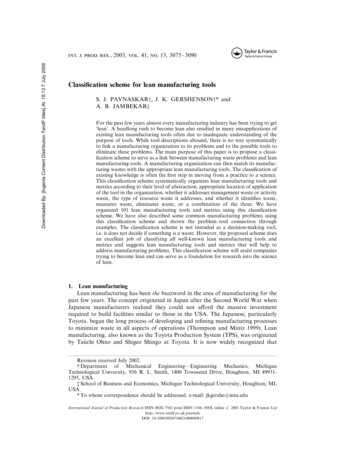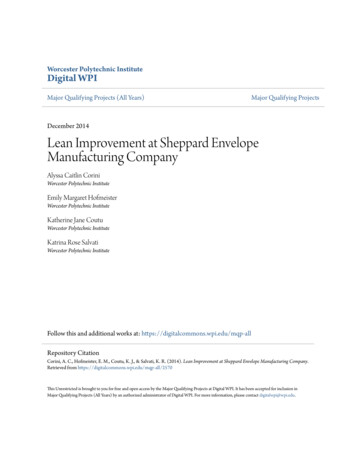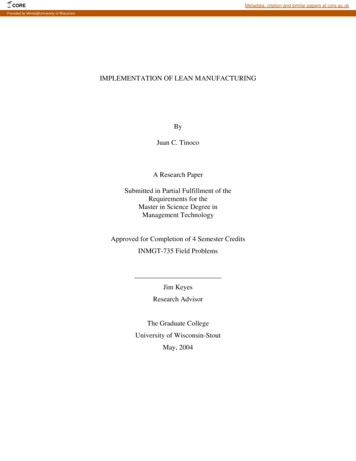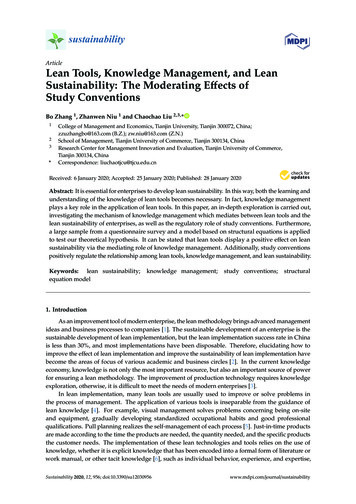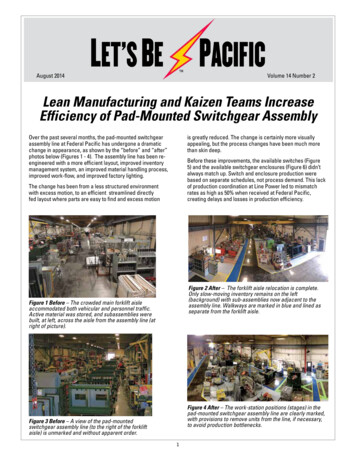
Transcription
August 2014LET’S BE PACIFICVolume 14 Number 2Lean Manufacturing and Kaizen Teams IncreaseEfficiency of Pad‑Mounted Switchgear AssemblyOver the past several months, the pad-mounted switchgearassembly line at Federal Pacific has undergone a dramaticchange in appearance, as shown by the “before” and “after”photos below (Figures 1 - 4). The assembly line has been reengineered with a more efficient layout, improved inventorymanagement system, an improved material handling process,improved work-flow, and improved factory lighting.is greatly reduced. The change is certainly more visuallyappealing, but the process changes have been much morethan skin deep.Before these improvements, the available switches (Figure5) and the available switchgear enclosures (Figure 6) didn’talways match up. Switch and enclosure production werebased on separate schedules, not process demand. This lackof production coordination at Line Power led to mismatchrates as high as 50% when received at Federal Pacific,creating delays and losses in production efficiency.The change has been from a less structured environmentwith excess motion, to an efficient streamlined directlyfed layout where parts are easy to find and excess motionFigure 2 After – The forklift aisle relocation is complete.Only slow-moving inventory remains on the left(background) with sub-assemblies now adjacent to theassembly line. Walkways are marked in blue and lined asseparate from the forklift aisle.Figure 1 Before – The crowded main forklift aisleaccommodated both vehicular and personnel traffic.Active material was stored, and subassemblies werebuilt, at left, across the aisle from the assembly line (atright of picture).Figure 4 After – The work-station positions (stages) in thepad-mounted switchgear assembly line are clearly marked,with provisions to remove units from the line, if necessary,to avoid production bottlenecks.Figure 3 Before – A view of the pad-mountedswitchgear assembly line (to the right of the forkliftaisle) is unmarked and without apparent order.1
Before these improvements, the available switches (Figure 5) and theavailable switchgear enclosures (Figure 6) didn’t always match up.Switch and enclosure production were based on separate schedules,not process demand. This lack of production coordination at Line Powerled to mismatch rates as high as 50% when received at Federal Pacific,creating delays and losses in production efficiency.Figure 5Figure 6BackgroundA key improvement tool used at Federal Pacific and LinePower to achieve these process improvements is throughthe use of cross-functional “kaizen” teams in order toget a broader view of the existing situations and potentialimprovements. Kaizen (roughly translated as “good change”)is often thought of as incremental process improvements, butit may also refer to more targeted, often time-bound, “kaizenevents” to address specific process improvements.This change process in the Pad-Mounted Switchgear line atFederal Pacific began with an opportunity for improvement(sometimes known as a “problem”) in the production flow.Federal Pacific was experiencing a mismatch between (1) theswitches and fuse mounting parts when paired with (2) therequired enclosures, all of which are supplied by our crosstown sister division, Line Power. The switchgear could notbe assembled at Federal Pacific without these two key setsof components (as well as other required parts) meeting up,on time, at the correct assembly locations on the productionline. The identified in-process mismatch rates occasionallyreached as high as 50%, resulting in delays and productioninefficiencies.The goal of the Federal Pacific (EMC) Pad-Mount ValueStream is to achieve the “lean manufacturing” objective ofreducing the lead time to the Customer by eliminating waste.This goal was addressed through the following three keyleverage points in the process:The method used to attack this issue was to utilize toolsof lean manufacturing by way of cross-functional Kaizenteams of associates from the affected production areas,supporting departments, engineering, and other areas of thecompany, all overseen by Fred Holt, our internal expert in leanmanufacturing processes.Leverage PointInventoryThe Lean Manufacturing Process ModelLean manufacturing is a business process model thatstresses the elimination of waste, which is defined as anyactivity that does not add value for the customer. The leanmanufacturing system focuses on reducing the lead timeto the customer through elimination of waste. Process,manpower and material stability are key to delivering aquality product to the customer on time.Parts AvailabilityChangeover Time2Opportunity for ImprovementControl and reduce the partsinventory Use pull vs push processEliminate multiple schedulesChange the way parts areordered Use Kanbans vs businessoperating system (defined onpage 3) Reduce batch sizes
The first step in the process was to address the switchassembly shop at Line Power, where the Auto-jet switchesand fuse mountings, along with the associated subassemblies and parts, are produced. A series of “kaizenevents” were used to improve the process, reduce work inprocess, eliminate multiple schedules, and to kit parts.system. The Kanban approach is based on the model of asupermarket, where the shelves are restocked, based oncustomer usage, creating a demand on the supply chain.As stock of an item on the shop floor is depleted from itsKanban bin (literal or figurative), a Kanban card (physicalor electronic) is generated which signals the need toreplenish that item, creating a demand on the logisticssystem. Typically, there are one or two bins used as a buffer,depending on the lead time for that item.In addition, one of the tools in transitioning from a schedulingbased production system (pushing the production) to ademand-based production system (where usage pullsproduction to support actual needs) is the use of a “Kanban”Kaizen EventsFigure 7 Before – Push production in blade assembly area,resulting in an excess of and potential damage to, inprocess material.Figure 8 After – Production based on need (“pulled” by thenext process), resulting in less in-process inventory whilebetter meeting production needs.1) Reduce operational wastes at fuse-mount and contactassembly production line at Line Power2) Reduce wastes involved with puffer, pump and bladeassemblies at Line Power (Figures 7 and 8)ActionsConsolidated assembly from two physically separatedlocations to one streamlined work flow to reduce wastedmotionActionsReduced cycle time by eliminating various motion wastesEliminate scheduled production by switching from Push(arbitrary, schedule driven) to Pull (demand driven –“maintain a supermarket” / “stocked shelves”)Results61% footprint reduction of assembly area83% inventory reduction50% cycle time reductionReduce Inventory through fixed inventory lanes (when thelane is full, stop producingImprove process flow and work in process by moving pufferassembly next to pump assemblyResults33% footprint reduction36% inventory reductionCycle time reductions ranging from negligible to 60%, dependingon itemQuality improvements due to reduced in-process (handling andstorage) damage3
Kaizen Events3) Implemented “Signal Process” to coordinate production of Equipment Cases with associated internal components (switches, fusemounts, and fuse contact assemblies) at Line Power (Figures 9 and 10)Results30% Inventory ReductionMotion wastes and assembly delays were virtually eliminatedBetter coordinated production of components with actualprocess demandReduced in-process inventory of finished componentsActionsEliminated multiple schedules by using Google Docs.Fabrication of an enclosure drives the production of switches,fuse mountings and fuse contacts needed to complete aparticular unit of pad-mounted switchgear by serial number.Completed switches, fuse mountings and contacts aretransported together as a kit, by unit serial number, with therespective enclosures, from Line Power to Federal Pacific.Figure 9 – Fabrication personnel enter the serialnumber applicable to the enclosure, driving switchassembly to begin production of the required majorcomponents.Figure 10 – Monitors in the switch assembly shop show the enclosures beingcompleted. This provides the “schedule” for producing switch and fusecomponent assemblies that are to be installed in those specific enclosures.4) Implemented “Orange Carts” for kitting Switches, Fuse Mounts and Fuse Contacts by unit serial number for transportation fromLine Power to Federal Pacific (Figures 11 and 12)ActionsResultsSwitches, Fuse Mounts and Fuse Contacts are placed onInventory reduced 50% at Federal Pacificcustom-designed orange shipping carts at Line Power,Motion Waste & Assembly Delays at Federal Pacificmatched to the switchgear serial numberassociated with missing or mismatched parts are virtuallyBoth the Orange Cart and the associated switchgear enclosureeliminatedmust be shipped together, by serial number, from Line Power toFederal PacificFigure 11 Before – The switches, fuse assemblies and contacts wereproduced in batches and stored accordingly4Figure 12 After – Switches and fuse components areproduced as needed and are associated with a specific,serially numbered enclosure, by customer job order
Kaizen Events5) Implemented “parts kitting” of major components (other than switches and fuse components mountings) by the serial numberof the pad-mounted switchgear to be built at Federal Pacific (Figures 13 -16)OpportunitiesImprove the average production rateExpectationsEliminate waste and balance line so that productionthroughput is improved by 20%Inventory not properly allocated and sometimes difficult tolocate when neededImprove inventory control and trackingActionsKitted parts by serial number to match up with specificenclosureResultsThis process change was recently implementedResults are being accumulatedInstituted Kanban system to ensure adequate andappropriate inventory of required parts when neededFigure 13 Before – Loosely controlled randomly locatedparts inventory resulted in searching for needed parts.Figure 14 After – Kitting area, using Kanban stockingsystem.Figure 15 After – Area manager updates the system todisplay serial numbers of completed parts kit carts, whichappear on the monitor.Figure 16 After – Parts kit cart is matched to its associatedenclosure on the assembly line.5
Figure 17 – New layout of the pad-mounted switchgear assembly line (units travel right to left) with components feeding into thesix-stage assembly line (prep, switch, buss, doors, fiber, and button-up). After these assembly processes are completed, and theroof has been installed, the completed unit then moves into the test area.After the Lean Manufacturing improvements, theorange carts (Figure 18) carrying the switches,fuse mounts and contacts are now aligned withthe enclosures by serial number. As a result,there is a noticeable reduction of enclosureinventory at Federal Pacific (Figure 19), as wellas an overall decrease of in-process stock, whileachieving an overall increase in availability.Figure 18Figure 196
Kaizen TeamsAt WorkFigure 20 – Kaizen programs are a true team effort. The collage above shows just a few of the team sessions that occurredwhile the pad-mounted switchgear line (and the component assembly lines) was thoroughly revamped.Through the ongoing process of continuous process improvement and lean manufacturing techniques, Federal Pacific expectsto further increase the throughput capability of the pad-mounted switchgear line by an additional 30% over the 20% improvementalready described in this newsletter. These process improvements will allow Federal Pacific to maintain the best lead times in theindustry, while, at the same time, maintaining and improving the quality of our switchgear products.7
2014 Electro-Mechanical CorporationThis document contains proprietary information of Electro-Mechanical Corporation or its operating divisions in whom title remains. Anyreproduction, distribution, disclosure or use not otherwise expressly approved in writing is strictly prohibited. Designated trademarksand brands are the provperty of their respective owners.8
Aug 01, 2019 · Lean Manufacturing and Kaizen Teams Increase Efficiency of Pad‑Mounted Switchgear Assembly Over the past several months, the pad-mounted switchgear assembly line at Federal Pacific has undergone a dramatic change in appearance, as shown by the “before” and “after” photos below (Figure



